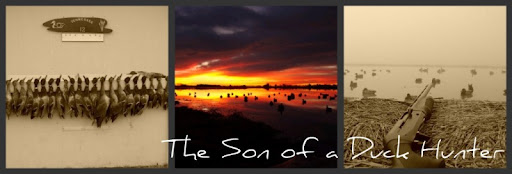Some people say bad luck comes in threes. This past duck season, it was the opposite for me when good luck came in threes......three bands that is. Duck and goose bands are one of the many mystiques of this wonderful past time. Each tells a story about the duck’s or goose’s past.
Some of you may be wondering what a band is or what they look like. The Bird Banding Laboratory website goes into further detail about bird bands. The next logical question would be Why band birds? Don’t worry; problem solved, thanks to the wonderful people of BBL.
Learning about a band on a duck or goose truly fascinates me. (It’s a shame they didn’t have a subject for this in school; I might have been a better student.) Each band is engraved with a unique nine digit number. This nine digit number is used to report an encounter with a banded duck or goose. By calling in the band number (1-800-327-BAND) or registering it online, you can find out where the duck or goose was banded, when it was banded, who banded it, the age and sex of the bird, as well as many other interesting facts. You are then mailed a 5x7 certificate with all these facts and it looks really great once framed (as I do with all mine).
 |
| What a band certificate looks like. |
 |
| Just a fraction of the wall of fame. |
One can only imagine the lakes, rivers, ponds and other bodies of water each banded bird has visited while making their way up and down the flyways. In the continental U.S., there are four major flyways for migratory waterfowl. (As seen on the map from the BBL website.) They are the Atlantic, Mississippi, Central and Pacific flyways with the Mississippi flyway being the largest.
All my bands have come from the Mississippi flyway with the exception of one. This picture is of a Drake Mallard I killed on September 22, 2010 while hunting in the Peace River Valley of Alberta, Canada. I can only assume he migrated down either the Pacific or Central flyway due to the location where he was killed in Alberta. I will never know since I killed him before he migrated south for the year. This is the first of three bands this hunting season.
Here is some info from the band :
 |
| Most hunters, like myself, wear their bands on their lanyards as in the picture above. |
Mallard
Sex: Male
Banded: August 23, 2009
Age: Hatched in 2009
Banding Location: Cardinal Lake, 20 W Peace River, Alberta, Canada
Encountered: September 22, 2010 at Cardinal Lake (The same exact lake where he was banded and born a year earlier). This means he migrated south to who-knows-where and came back to the same place he was born! How fascinating is that?!
Band number two was on a Lesser Snow Goose - my first ever Snow Goose band, might I add.
Info from the Snow Goose band:
Lesser Snow Goose
Sex: Won’t know until I receive the certificate in the mail.
Banded: July 23, 2008
Age: Won’t know until I receive the certificate in the mail.
Banding Location: Manitoba
Encountered: January 24, 2011 a mile west of the house in Crocketts Bluff, Arkansas across from the Lybow field (shout out to the gunslinger from the east). At least a three year old goose.
Finally, my pride and joy of the three bands this year - a rare Northern Pintail band.
Info from the Pintail band:
Northern Pintail
Sex: Male
Banded: August 23, 2006
Age: Won’t know until I receive the certificate in the mail.
Banding Location: Saskatchewan
Encountered: January 29, 2011 at Wolf Island. (He was five years old. That means he migrated up and down the flyway five times! I can only imagine how many miles he had flown!)
Bands, just as the ones pictured above, are an absolute and lifelong treasure, as well as a rarity, in duck hunting. However, having many bands is not a reflection on how hard a waterfowler hunts as it is, in my opinion, more a reflection on where you hunt. If a duck hunter hunts near an area where the USFW Service bands a high number of birds, well, more than likely, he or she is going to have more bands than a person who doesn’t hunt near such an area. What I’m trying to convey is that getting a band is nothing more than being at the right place at the right time. It revolves around the big L word....luck. I know waterfowlers that have many bands but couldn’t blow a duck call if their life depended on it. I also know waterfowlers who have very few bands and are absolute studs in this sport. In turn, I think that alone makes them even more special and unique. A blessing, if you will, that I will always cherish for the rest of life. So tell me, do you have any good band stories? I eat them up, so post away fellas.







